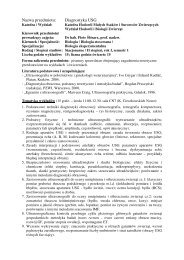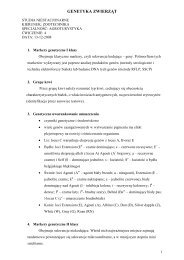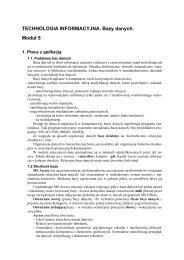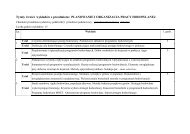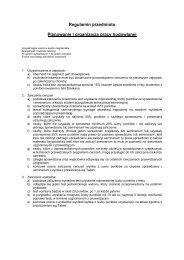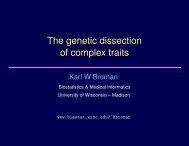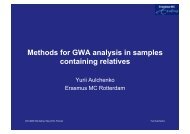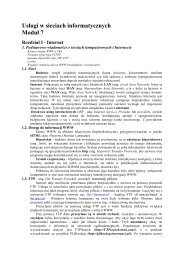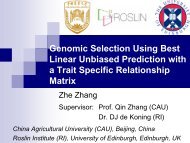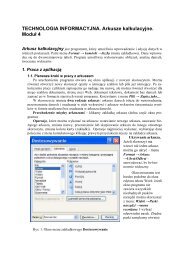The book of abstracts is available. - PoznaÅ
The book of abstracts is available. - PoznaÅ
The book of abstracts is available. - PoznaÅ
You also want an ePaper? Increase the reach of your titles
YUMPU automatically turns print PDFs into web optimized ePapers that Google loves.
14 th QTL-MAS Workshop, Poznań University <strong>of</strong> Life Sciences, Poland 2010Using genome scans <strong>of</strong> DNA polymorph<strong>is</strong>m to identify regions exhibitingpositive selectionS. Qanbari 1∗ , D. Gianola 2 , B. Hayes 3 , F. Schenkel 4 , S. Miller 4 , S. Moore 5 , G. Thaller 6 , H.Simianer 11Animal Breeding and Genetics Group, Department <strong>of</strong> Animal Sciences, Georg-August University, 37075Göttingen, Germany2Department <strong>of</strong> Animal Sciences and Department <strong>of</strong> Dairy Science, University <strong>of</strong> W<strong>is</strong>consin-Mad<strong>is</strong>on, Mad<strong>is</strong>on,W<strong>is</strong>consin 53706, USA3 Animal Genetics and Genomics, Primary Industries Research Victoria, 475 Mickleham Rd, Attwood, VIC3049, Australia.4Centre for Genetic Improvement <strong>of</strong> Livestock, Animal and Poultry Science Department, University <strong>of</strong> Guelph,Guelph, Ontario, N1G 2W1 Canada5Department <strong>of</strong> Agricultural, Food and Nutritional Science, University <strong>of</strong> Alberta, Edmonton, AB, Canada6Institute <strong>of</strong> Animal Breeding and Animal Husbandry, Chr<strong>is</strong>tian-Albrechts-University, 24098 Kiel, Germany∗ Presenting author: Saber Qanbari, email: sqanbar@gwdg.deIn th<strong>is</strong> study, two different and complementary methods were applied to identify traces <strong>of</strong>decades <strong>of</strong> intensive artificial selection for traits <strong>of</strong> economic importance in modern cattle.We scanned the genome <strong>of</strong> a diverse set <strong>of</strong> dairy and beef breeds from Germany, Canada andAustralia with a 50K SNP panel. In the first study we employed the integrated HaplotypeHomozygosity Score (|iHS|) for tracing on-going sweeps. Across breeds, a total <strong>of</strong> 109extreme |iHS| values exceeded the empirical threshold level <strong>of</strong> 5% with 19, 27, 9, 10 and 17outliers in Holstein, Brown Sw<strong>is</strong>s, Australian Angus, Hereford and Simmental, respectively.Annotating the regions harboring clustered |iHS| signals to the genome revealed significantenrichment for functional genes like SPATA17, MGAT1, PGRMC2 and ACTC1, COL23A1,MATN2, respectively, in the context <strong>of</strong> reproduction and muscle formation. In the secondanalys<strong>is</strong> a new Bayesian F ST -based approach was applied with a set <strong>of</strong> geographicallyseparated populations including Holstein, Brown Sw<strong>is</strong>s, Simmental, Canadian Angus andPiedemontese for detecting differentiated loci. <strong>The</strong> algorithm used <strong>is</strong> able to process a largebattery <strong>of</strong> marker information and allows inference based on the posterior d<strong>is</strong>tribution <strong>of</strong> F STvalues. In total, 127 regions exceeding the 2.5 per cent threshold <strong>of</strong> the empirical posteriord<strong>is</strong>tribution were identified as extremely differentiated. To a substantial proportion (56 out <strong>of</strong>127 cases) the extreme F ST values were found to be positioned in poor gene content regionswhich deviated significantly (p < 0.05) from the expectation assuming a random d<strong>is</strong>tribution.However, significant F ST values were found in some gene regions, like SMCP and FGF1. Aremarkable observation in th<strong>is</strong> study <strong>is</strong> a selection signal confirmed by both |iHS| and F STanalyses in the vicinity <strong>of</strong> Sialic acid binding Ig-like lectin 5 gene on BTA18 which recentlywas reported as a major QTL on productive life and fertility traits in Holstein cattle. Overall,based on the results <strong>of</strong> th<strong>is</strong> study we conclude that high-resolution genome scans are capableto identify outlier regions that potentially contain genes contributing to within and inter-breedphenotypic variation.29



